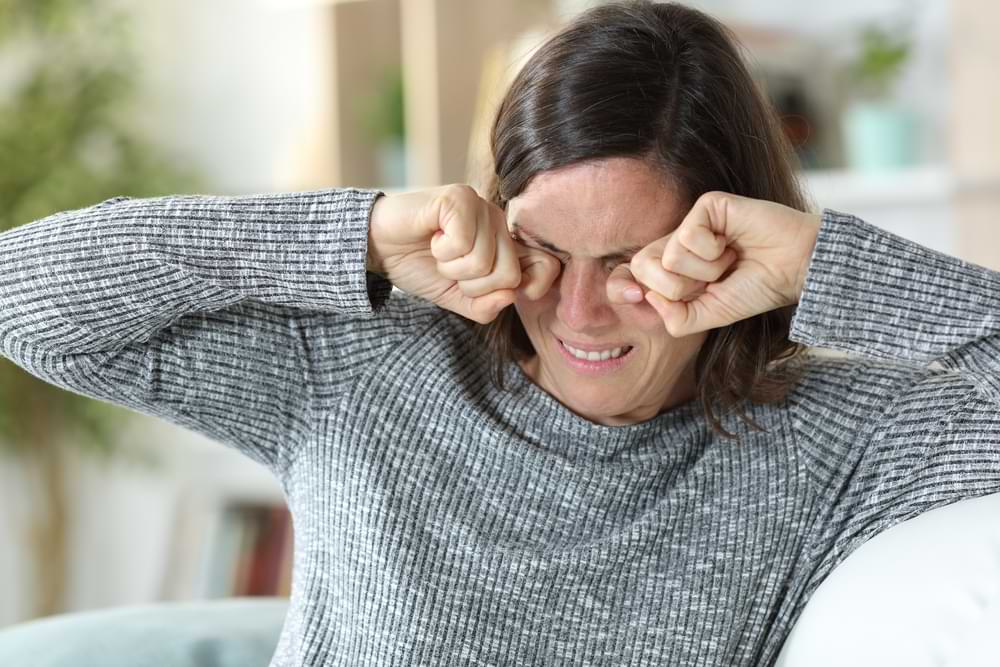Dry Eye Treatment in Tasmania
As an experienced optometrist, I’ve had enquiries about all kinds of eye-related conditions. However, one enquiry that I often encounter is from patients around the state is how to I get dry eye treatment in Tasmania?
I’m Martin Robinson, the owner and principal optometrist at Martin’s Eyecare, in Hobart.
If you find yourself frequently reaching for eye drops or searching for “natural dry eye treatments”, this article is for you.
What is Dry Eye Syndrome?
At its core, dry eye syndrome is an issue with the tear film that covers our eyes. Our tear film is made up of three main layers and countless molecules, which are crucial as they perform several functions. These include nourishing our cornea, stabilizing the tear film, fighting microbes, clearing away dust and pollen and most importantly it ensures clear vision. Without it, we experience discomfort, vision issues, and potential eye damage.
Dry eye syndrome may come in a few subtypes:
- Aqueous Deficient Dry Eye (ADDE): This is characterized by a decreased production of the watery component of tears.
- Evaporative Dry Eye (EDE): This occurs where there is a dysfunction in the tiny oil-producing glands (Meibomian Glands) located in the eyelids. This is the most common subtype of dry eye and leads to rapid evaporation of the tear film from the surface of the eye.
Many patients may have mixed-type dry eye, where elements from both ADDE and EDE are present. Identifying the specific subtype is crucial for tailoring the right therapeutic approach.
What Causes Dry Eyes?
Some reasons for experiencing irregularities with tear film include:
- Natural Aging Process: With advancing middle age, the body’s natural tear production decreases and the meibomian glands may become less effective. Dry eye becomes more prevalent as individuals reach their 40s and 50s.
- Environmental Factors: Tasmania’s unique climate, with its mix of breezy coastlines and crisp low humidity, can exacerbate dry eyes.
- Medical Conditions: Health problems like diabetes can affect your eyes’ ability to produce tears due to nerve damage and changes in tear quality. Cancer treatment can require chemotherapy, this can adversely affect the meibomian glands which produce oils for our eyes.
- Medications: Some drugs have side effects which impact tear production. For example, the acne treatment drug Isotretinoin (a.k.a. Roaccutane), can interfere with the natural function of the meibomian glands.
- Eye Procedures: LASIK surgery can disrupt the corneal nerves, leading to reduced tear production and dry eyes. For most patients, this dryness typically lasts for a few weeks to a few months. As the corneal nerves gradually heal and regenerate, tear production normalizes and dryness alleviates.
- Incomplete Blinking/Blink Rate: Our increasing computer screen time, whether for work or leisure, puts strain on our eyes. Extended screen use changes our blink patterns leading to incomplete closure during blinks and a reduced number of blinks, both contribute to our eyes drying out, especially in low-humidity office environments.
- Blepharitis and Bacteria: One common condition associated with dry eyes is blepharitis, which is an inflammation of the eyelids. It’s often caused by bacterial infections or an overgrowth of the bacteria that normally live on the eyelids. This bacterial overgrowth can lead to inflammation of the meibomian glands located in the eyelids.
- Ocular Rosacea: This is an extension of rosacea, a chronic skin condition that primarily affects the face. It can produce redness and irritation of the eyes and swelling of the eyelids. Ocular rosacea can cause dysfunction of the meibomian glands.
- Demodex Mites: When microscopic mites infest the base of the eyelashes, they can cause inflammation and blockage of the nearby meibomian glands. Small numbers of these mites are normal and usually harmless to humans. But an overpopulation of these tiny parasites can be another lead cause of complications in the normal function of your eyelid glands.
Do I Have Dry Eye Syndrome?
People often realize they may be experiencing dry eye syndrome when they begin to notice persistent and recurrent symptoms that interfere with their daily activities or comfort. Here are some common triggers and circumstances that prompt individuals to seek dry eye treatment in Tasmania:
- Persistent Discomfort: Experienced as a burning, gritty, or scratchy sensation in the eyes. This discomfort might become particularly noticeable during certain activities, like reading or using a computer.
- Reliance on Over-the-Counter Solutions: Individuals might find themselves frequently using over-the-counter eye drops or “artificial tears” but obtaining only temporary or insufficient relief.
- Vision Fluctuations: You may have dry eye syndrome if you notice periods of blurred vision that improve with blinking.
- Sensitivity to Light: An increased sensitivity to light, especially bright lights or screen glare, can be an indication.
- Environmental Triggers: Situations such as being in a dry, windy environment or a place with air conditioning might exacerbate symptoms.
- Red Eyes: Persistent redness or a “bloodshot” appearance can be a sign.
- Trouble with Night Driving: Glare and halos around lights while driving at night might be a dry eye indication.
- Contact Lens Discomfort: Those who wear contact lenses might find them increasingly uncomfortable to wear or might experience shorter wear times.
- Excessive Tearing: Ironically, one symptom of dry eye can be watery eyes. This is the eye’s reflex response to the dryness, trying to compensate by producing more tears, but these tears are often of poor quality and don’t provide relief.
Sometimes, people might not be aware of the condition until it’s brought up during a regular eye examination. Early treatment can prevent the condition from worsening and keep your eyes healthy for the long term.
Dry Eye Treatment in Tasmania: Advanced Scanning With the OCULUS Keratograph® 5M
For an accurate diagnosis, you need to have a comprehensive consultation with a trained eye care professional. In my clinic, we discuss your symptoms and medical history in detail.
But what sets my approach apart is the use of the Oculus Keratograph 5M from Germany for a detailed anterior eye and tear film health analysis.
The OCULUS Keratograph® 5M is a high-tech diagnostic device that can capture detailed images of the eye’s surface. It has special features that allow it to check the oil-producing glands in the eyes, measure tear quality, and assess the tear layer’s thickness. It’s like a specialized camera for understanding and analysing various aspects of eye health.
Martin’s Eyecare is one of only two optometrists in the whole of Tasmania with this advanced equipment.
Here’s are a few reasons why we decided to invest in this addition to our eye care practice:
- Comprehensive Eye Health Analysis
- Tear Film Checks: With the Keratograph® 5M, I can get a clear picture of your tear film, spotting even the smallest issue before it becomes a bigger problem.
- Redness Detection: The new R-Scan feature lets me detect and measure eye redness with accuracy. It’s objective and more reliable than old diagnostic methods.
- Meibomian Gland Examination: I can see the health of the meibomian glands and determine if they are the real cause of your dry eye problems.
- Enhanced Patient Consultation and Education
- In-Depth Imaging: It’s easier to explain things to my patients with clear images. The detailed visuals from the Keratograph® 5M help me show patients what’s happening with their eyes, which makes our conversations more productive.
- Easy-to-Understand Displays & Reports: I want my patients who undergo recurring dry eye treatments to be able to easily track their progress towards improved eye health.


Simple Steps Toward Dry Eye Prevention
Depending on the cause and severity, various natural and common sense strategies might be suitable if you suffer from dry eyes. Some things you can do on your own if you are seeking dry eye treatment in Tasmania include:
- Lifestyle Changes: Prolonged screen exposure can strain our eyes and decrease the frequency of our blinking, leading to dryness. Simple adjustments, such as taking regular breaks from screens can greatly reduce this strain.
- Dietary Changes: Fish oils, particularly those rich in omega-3 fatty acids, have become increasingly recognized for their potential benefits in managing dry eye syndrome. Omega-3 fatty acids, primarily found in certain fish like salmon, mackerel, sardines, and albacore tuna, have natural properties that can help reduce the inflammation often associated with dry eye.
- Warm Compress: A traditional and effective remedy involves placing a warmed cloth or special mask over closed eyelids. The heat from the compress helps to melt the solidified oils in the meibomian glands, allowing them to flow more freely. This action improves the quality of the tear film and can provide relief from the symptoms of dry eyes. Warm compresses are a simple and cost-effective solution that can be easily done at home. But they are not always helpful, especially in cases of roseacea where heat packs can increase inflammation.
- Eyewear Protection: For those who spend considerable time outdoors, especially in mountainous regions or by the ocean, wearing protective eyewear like wraparound sunglasses can block out the wind and reduce the risk of environmental dry eye aggravation. We stock Seven Eyes and Zienna dry eye sunglasses and spectacles which help protect your eyes from wind and the environment.
- Eye Drops: Over-the-counter artificial tears are readily available solutions designed to mimic the natural lubrication of our eyes. These eye drops are formulated to replenish the moisture level of the eyes, offering immediate relief for mild symptoms. They are often composed of water, salts, and polymers that aim to stabilize and maintain the tear film’s integrity.
- Humidifiers: A simple device can help increase the humidity in a room, which can be beneficial in reducing tear evaporation.
Dry Eye Treatment Products
There are a number of dry eye products available for purchase online or through chemists. However, it’s always advisable to check with your eye care professional first, to determine if these are suitable for you. There are many that are only available through optometry clinics.
- Blephasteam Goggles: This is a device designed specifically for treating Meibomian Gland Dysfunction (MGD). It provides a moist and warm environment for the eyelids using steam release. By applying controlled heat, Blephasteam helps to soften and release the thickened oils in the meibomian glands, allowing them to function better. This improves the lipid layer of the tear film, reducing evaporation and alleviating dry eye symptoms.
- Zocushield Gel: This is a hygiene product from the Zocular brand, which is designed for daily eyelid cleansing. It utilizes the benefits of okra and other natural ingredients to help manage and prevent conditions like blepharitis, dry eye, and meibomian gland dysfunction.
- Eyelid Cleansing Foams: These are gentle cleansers specifically formulated to clean the delicate eyelid area without causing irritation. They can help remove debris, oils, and any potential allergens that could contribute to eye irritation.
- Hypochlorous Acid Sprays: These sprays have antimicrobial properties and can help reduce bacterial load and inflammation on the eyelids. They are often used for conditions like blepharitis.
- Liposomal Eyelid Sprays: When the liposomal eyelid spray is applied, the liposomes release their contents onto the eyelids and lashes. As you blink, these contents, including lipids, spread across the surface of the eye, supplementing and stabilizing the natural lipid layer of the tear film.
- Tea Tree Oil Foams and Sprays: Tea tree oil has anti-demodex properties which can be effective in countering these mites that infest the base of eyelashes and and cause irritation of the meibomian glands.
- Ocular Surface Save Cosmetics: Eyes Are The Story make a range of eye safe cosmetics including mascara, eyeliner, facial cleanser, eye serum. The Eye Doctor make eye safe cosmetic removal liquids.
Clinical Dry Eye Treatment For Patients in Tasmania
More severe and chronic cases of dry eye suffering will require working closely with your optometrist to find solutions. At Martin’s Eyecare we are happy to discuss the following treatment approaches, and co-manage your care with both General Practitioners and Ophthalmologists:
- Prescription Medications: Dry eyes can arise from various causes, and different medications address may these root issues. For those producing fewer tears, drugs like pilocarpine can help increase tear production. If the problem is inflammation, corticosteroids, available in a range of eyedrops, can be used, but with caution due to potential side effects. For persistent inflammation not responding to typical anti-inflammatories, immunosuppressive agents like cyclosporine (Restasis) or lifitegrast (Xiidra) are used. And for bacterial-related dry eyes, hypochlorous acid sprays help as well as antibiotics, either in drop form or pills.
- Mastrota Paddle Expression: This procedure involves using a special instrument, the Mastrota paddle, to express the contents of the meibomian glands. The procedure gently squeezes or pushes out the oils from the tiny glands along the edges of the eyelids. Think of it like squeezing toothpaste from a tube, but in this case, it’s releasing built-up oils that block the meibomian glands, preventing them from keeping our eyes moist.
- Lid Debridement: This is a procedure where the edges of the eyelids are cleaned to remove any debris, crusts, or excess oils. It can help treat conditions like blepharitis, where the eyelid margins become inflamed, often due to a build-up of bacteria or dandruff-like flakes. Think of this as like a scale and clean for the eyes like your dentist performs for your teeth.
- Lacrimal Lavage: This procedure is used to flush or clean the lacrimal drainage system (the system responsible for draining tears from the eyes). It involves introducing a saline solution into the puncta (small openings at the inner corner of the eyelids) to ensure that the tear drainage pathway is open and functioning properly.
- ZEST (Zocular Eyelid System Treatment): ZEST is a treatment designed to target the root cause of eyelid issues like blepharitis. It involves the application of Zocular’s proprietary okra-infused formulation to soothe the eyelids, reduce inflammation, and manage conditions of the eyelid margin.
Intense Pulsed Light Treatment (IPL)
At Martin’s Eyecare, we also offer Intense Pulsed Light treatment, which is a relatively new and highly effective approach to treating severe dry eye syndrome.
The treatment works by emitting bursts of light across a spectrum of wavelengths, targeting and breaking down hardened oils clogging the meibomian glands. Once these oils are liquefied, they can be easily expressed, leading to improved gland function and a healthier tear film composition.
Most patients typically require 3 to 4 sessions spaced a few weeks apart for optimal results. While some might notice improvement after the first session, it often takes multiple treatments to experience significant relief. The cumulative effect over these sessions ensures that the glands are thoroughly treated and can function efficiently, offering sustained relief from dry eye symptoms. Not all patients may be suitable for this treatment, as such we must evaluate you prior to starting any therapy.
Given the specialized nature of IPL treatments, not all optometrists offer them.
What If I Don’t Treat My Dry Eyes?
Untreated dry eye syndrome (DES) can lead to a range of complications over time. Potential long-term problems include:
- Increased Risk of Infections: The tear film serves as a protective layer for the eyes, helping to ward off infections. Reduced or poor-quality tears can compromise this protective function, increasing the risk of eye infections.
- Damage to the Eye Surface: Persistent dryness can lead to tiny abrasions on the cornea (the clear front surface of the eye). Over time, these repeated injuries can result in the formation of scars or irregularities on the cornea, affecting vision.
- Vision Interference: In severe cases, the lack of adequate lubrication can lead to a decrease in visual clarity. Fluctuations in vision or blurred vision can become more frequent.
- Decreased Tolerance to Certain Environments: People with untreated DES might find it increasingly difficult to tolerate environments with low humidity, such as airplanes or air-conditioned rooms. This can impact their ability to travel or be in specific settings comfortably.
- Compromised Surgical Outcomes: For those considering eye surgeries, untreated DES can increase the risk of complications or unsatisfactory results.
It’s important to note that the severity and progression of dry eye syndrome can vary among individuals. While some might experience only mild symptoms, others can face significant discomfort and complications. Regular eye check-ups and early dry eye treatment intervention can help manage the symptoms and prevent long-term problems.
Conclusion
As a dedicated optometrist, I’ve seen firsthand the impact of dry eyes on daily life. It’s why I’ve invested in the best equipment and treatments, like the OCULUS Keratograph® 5M and Intense Pulsed Light Treatment (IPL), to offer dry eye relief to my patients.
Remember, if you’re experiencing any symptoms, don’t hesitate. Reach out, and let’s ensure your eyes remain as beautiful as Tasmania’s landscapes!
